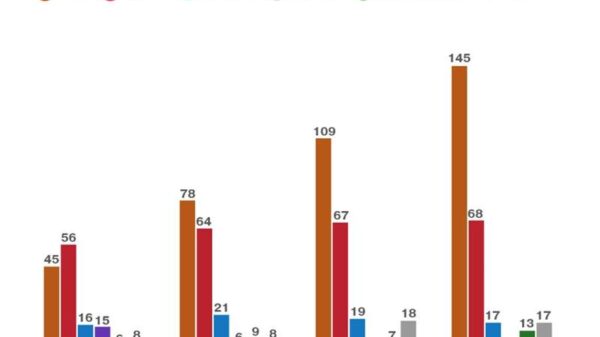The word “Bidenflation” appeared in the news last summer, politicizing inflation and assigning blame for it. By December, the Consumer Price Index had risen 7 percent from a year earlier, the largest annual increase since the end of the Great Inflation, the period of entrenched inflation from 1965 to 1982.
On Dec. 14, when asked about the drivers of the recent inflation, Jen Psaki, President Biden’s press secretary, answered with an example: “The president, the secretary of agriculture have both spoken to what we’ve seen as the greed of meat conglomerates.”
Her answer lent support to the idea that the United States is about to enter a “wage-price spiral,” an economic theory that posits a greed-enabled vicious feedback loop between consumer price inflation and cost increases: Greedy businesses raise prices to increase profits, which causes greedy unions to demand higher wages, which causes businesses to raise prices again, and so on. We are now seeing reports of newly assertive union members demanding higher wages, and of greedy corporate price setters charging too much.
But feeding fears of a wage-price spiral can be dangerous, especially if Americans view it as something that might continue indefinitely. Once lawmakers, business leaders and consumers come to believe the spiral has really taken hold, that belief can amplify long-term inflation expectations. It can make people angry and rigid in their demands and depress the stock market and consumer confidence.
It’s the Federal Reserve’s mandate to keep inflation under control. It would be better if Americans let the Fed do its job, calming down and refusing to buy into these fears.
The idea of the wage-price spiral is a perennial story. An early iteration appeared in “The World’s Crisis,” an 1868 book by a newspaper editor named L.B. Woolfolk. During the Civil War, prices roughly doubled in the North and went up until the Confederate dollar became worthless in the South. An initial rise in the cost of living pushed workers to “clamor for an increase of wages,” Woolfolk wrote; employers obliged. But then followed “a struggle to obtain another rise of prices” to pay the higher wages, spurring a further increase in the cost of living, “and so the ball rolls on.”
An early appearance of the term wage-price spiral was in a 1937 Times article, “The Wage-Price Spiral,” about the repercussions of a strike settlement at U.S. Steel. The company claimed that the higher wages the strikers had won were forcing it to increase prices. The article opined that such disputes between labor and capital provoked “needless bitterness.”
By the early 1970s, pundits and presidents alike bought into the story of a link between unions pressing for higher wages and runaway inflation. Edwin Dale Jr., then a reporter for The Times and later a Reagan administration spokesman, wrote in 1971 that many Americans were “cynical and hopeless about the issue of union-won enormous wage increases and a subsequent price increase.” In his telling, the wage-price spiral was at fault.
That same year, President Richard Nixon announced that he would “break the vicious circle of spiraling prices and costs” with an executive order imposing a 90-day freeze on all wages and prices. Just five years earlier, Milton Friedman, a strong opponent of the wage-price spiral narrative, had warned against such controls. His warnings proved prescient: inflation continued throughout the 1970s.
Nixon’s successor, Gerald Ford, encouraged Americans to do their part to resist the wage-price spiral. With his program to “Whip Inflation Now,” a slogan emblazoned on campaign-style pin-on buttons, and in a televised address to the nation, he asked Americans to be nicer: “We can share burdens as we can share blessings.” The buttons lost the battle, but eventually, aggressive monetary policy under Paul Volcker brought the increase in inflation to an end, via the recession of 1981 to 1982.
Inflation is a problem of some importance, and a problem with a moral dimension. We owe it to all the owners of U.S. government debt — future generations — that we don’t erode the value of the dollar too much with inflation. But few people see it that way. In the mid-1990s, I studied economists’ views of inflation versus the public’s. By and large, members of the public were far more concerned about how inflation would affect their cost of living, real personal income and the value of the dollar than economists were.
The public tends to think of inflation as an indicator of a cycle of greed and inhumanity, as a conspiracy to rob them of their buying power. In reality, the cause is more technical, like an increase in the money supply or disruptions in the supply chain.
Only 8 percent of respondents in a recent Gallup poll named the cost of living or inflation as the most important problem facing America. That percentage has been rising, however, and that alarms me.
When people start to think that inflation is a measure of collateral damage in the battle between big business and aggressive labor — when they blame, in effect, the wage-price spiral — they feed into the rhetoric of both the extreme left and the extreme right. America doesn’t need another angry political narrative that may further erode our trust in each other, trust that we need for economic growth.
Robert J. Shiller, a professor at Yale, won the Nobel in economic science in 2013. He is the author, most recently, of “Narrative Economics: How Stories Go Viral and Drive Major Economic Events.”
The Times is committed to publishing a diversity of letters to the editor. We’d like to hear what you think about this or any of our articles. Here are some tips. And here’s our email: letters@nytimes.com.
Follow The New York Times Opinion section on Facebook, Twitter (@NYTopinion) and Instagram.


























